Sylheti Nagri Literature 
Sylheti Nagari or Syloti Nagri (Silôṭi Nagôri) is the original script used for writing the Sylheti language.It is an almost extinct script, this is because the Sylheti Language itself was reduced to only dialect status after Bangladesh gained independence and because it did not make sense for a dialect to have its own script,its use was heavily discouraged. The government of the newly formed Bangladesh did so to promote a greater "Bengali" identity. This led to the informal adoption of the Eastern Nagari script also used for Bengali and Assamese. The Sylheti-Nagari Script is more older than The Bengali Language ,which history is just 1000-1200 years old.
The traditionally story of the origin of the Syloti-Nagri alphabet is about 5000 years back. In the time of Mahabharata,when Sylhet or Sreehatta was a part of Bhagadatta's Kingdom and also traces of Sylheti-Nagari Script can be found in Puranas.According to a late text, Kalika Purana (c.7th–8th AD), the earliest ruler of Assam was Mahiranga Danav of the Danava dynasty, which was removed by Naraka who established his the Naraka dynasty. The last of these rulers, also Naraka, was slain by Krishna. Naraka's son Bhagadatta became the king, who, it is mentioned in the Mahabharata, fought for the Kauravas in the battle of Kurukshetra with an army of kiratas, chinas and dwellers of the eastern coast.In the late 17th century, Persian became the official language of
the Delhi Sultanate and the Perso-Arabic script was used in all official documents.
The Sylheti language and alphabet continued to be used by the ordinary people for everyday matters. In the 1860s, a Sylheti by the name of Moulvi Abdul Karim spent several
years in Europe and learnt the printing trade. After returning home,
he designed a woodblock type for the Syloti-Nagri alphabet and founded
the Islamia Press in Sylhet Town in about 1870. Other Sylheti presses
were established in Sunamgonj, Shillong and Calcutta. These presses
fell out of use during the early 1970s. Since then the Syloti-Nagri
alphabet has been used mainly by linguists and academics.
During the Hindu reawakening at the time of Sri
chaitanya (1486-1533), when
sanskrit
in Devanagari script was being widely used, Muslims started writing
books in their newly devised Sylheti Nagri. A printing press with
Sylheti Nagri typefaces was established in Sylhet sometime between
1860-1870 which helped spread the use of the script.
Moulvi
abdul karim
designed the typeface and founded the Sylhet Islamia Printing Press,
which was the first to print Sylheti Nagri. Later, other presses such as
Sylhet Sharada Printing Press, Sialdah Hamidi Press in
Kolkata, and General Printing Works on Gardiner Lane also printed books
in Sylheti Nagri. Two primers,
Sylheti Nagrir Pahela Ketab (The First Book of Sylheti Nagri) and
Sylheti Nagri Likha (Writing in Sylheti Nagri), helped the script gain a footing.
The language of the
puthis written in Sylheti Nagri and in
dobhasi is identical, lacking the use of
tatsama (Sanskrit) words. Many Persian and Arabic words are used in puthis written in Sylheti Nagri. In the fashion of dobhasi
puthis, those written in Sylheti Nagri were paginated from right to left.
The earliest extant manuscript written in Sylhet Nagri is Talib Huson by Gholam Huson (1549). Other manuscripts include Ragnama (1727) by Fazil Nasim Mohammad, Noor Nosihat (Enlightened Teachings, 1819), Ragnoor and Sat-kanyar Bakhan by Syed Shah Noor (1730-1854), Bhedsar by Shah Huson Alam (1750-1850), Mushkil Taran, Hasar Taran, Ragbaul, Keyamatnama, Shitalangi Rag by Shitalang Shah (1800), Haruful Khaslat (1875) by Nasim Ali (1813-1920), Halot-un-Nobi (Account of the Prophet, 1855), Mahobbat Nama, Hasor Michil, Raddequfur by Munshi Mohammad Sadeq Ali etc. Puthis such as Kadinama, Chhadchhi Machhla and Sonabhaner Punthi
by Abdul Karim were extremely popular. According to an estimate there
are about 150 extant Sylheti Nagri texts, in print or manuscript, by
about 60 people. Anonymous puthis include popular texts such as Harinnama, Hushiyarnama, Safatunnabi, Abu Sama, Nur Najat, and Penchar Galpa.
Sylheti
Nagri is found inscribed on Afghan coins that were minted towards the
close of the sixteenth century and the beginning of the seventeenth.
Some deeds written in Sylheti Nagri are preserved in the Sylhet District
Archives and Sub-Registry Office in
maulvi bazar. [Muhammad Ashraful Islam]
Notable features
- The alphabet is written in horizontal lines from left to right,
but Sylheti books are paginated from right to left. This means that
the front cover of a Sylhettan book is where the back cover of an
English book would be.
- This is a syllabic alphabet in which consonants all have an inherent
vowel. Other vowels are indicated with diacritics or separate letters.
The inherent vowel can be muted with a special diacritic called a
hasanta.
- Vowels can be written as independent letters, or by using a variety
of diacritical marks which are written above, below, before or after
the consonant they belong to.
- When consonants occur together in clusters, special conjunct letters
are used. The letters for the consonants other than the final one
in the group are reduced. The inherent vowel only applies to the final
consonant.
Used to write:
Sylheti, an eastern Indo-Aryan language spoken by around 10 million
in the Sylhet region of Bangladesh and in parts of India. Sylheti is
closely related to Bengali (Bangla) and most speakers are bilingual
in Sylheti and Bengali.
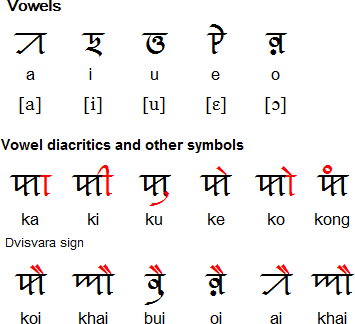
Note
- The dvisvara sign can attach to consonants to form the diphthong /oi/
with the inherent vowel, or it can also combine with dependent or independent
vowels to form other diphthongs. Those diphthongs can also be written with
the independent vowel i.
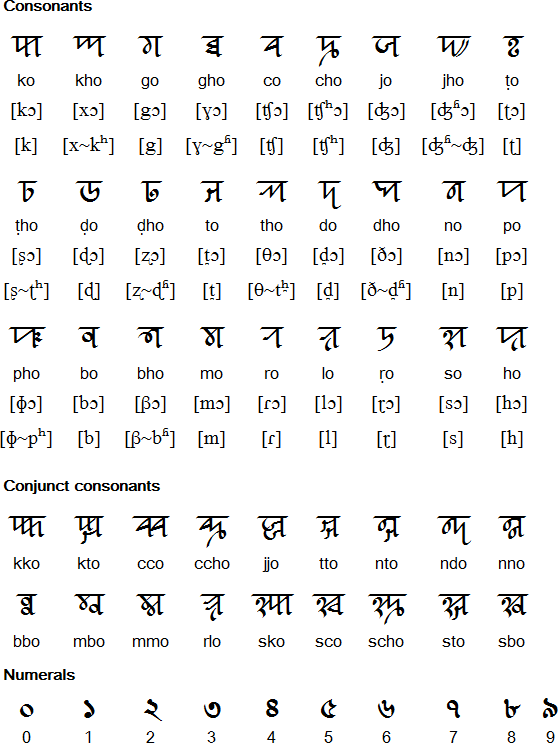
Bengali alphabet for Sylheti
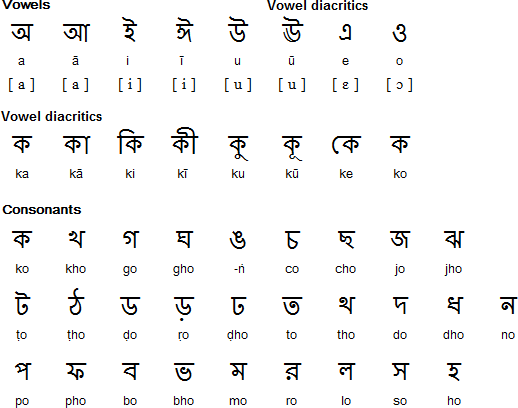
Latin alphabet for Sylheti
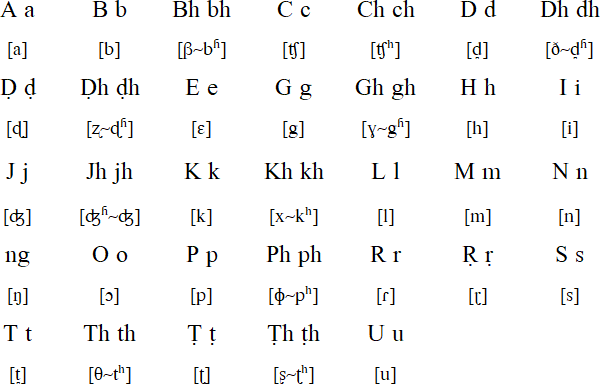 Information about the Sylheti scripts and pronunciation compiled or corrected by Wolfram Siegel
Information about the Sylheti scripts and pronunciation compiled or corrected by Wolfram Siegel
Links
Information about Syloti-Nagri alphabet
http://en.wikipedia.org/wiki/Sylheti_Nagari
Syloti-Nagri fonts
http://www.sylheti.org.uk/page5.html
http://www.wazu.jp/gallery/Fonts_SylotiNagri.html
Sylheti Translation and Research - a London-based research organisation
dedicated to studying the folk literature of the Sylhet region of Bangladesh:
http://www.sylheti.org.uk
Sylhet Nagri Texts Documentation Archive
http://www.compcon-asso.in/projects/sylhet/
http://www.compcon-asso.in/projects/sylhet/manuscripts/
Bengali and Sylheti Language Services
http://www.bengaliandsylheti.com
Indo-Aryan languages
Awadhi,
Assamese,
Bengali,
Bhojpuri,
Chakma,
Dhivehi,
Gujarati,
Hindi,
Kashmiri,
Konkani,
Kotia,
Kutchi,
Maithili,
Marathi,
Marwari,
Modi,
Nepali,
Oriya,
Punjabi,
Rajasthani,
Romany,
Saraiki,
Sindhi,
Sinhala,
Sourashtra,
Sugali,
Sylheti,
Urdu
Languages written with the Bengali alphabet
Bengali,
Garo,
Manipuri,
Mundari,
Sylheti
Also used to write: Bishnupriya, Bodo, Chakma, Chiru, Koda,
Nisi, Deori, Dimasa, Hajong, Koch, Khasi, Kudmali, Tiwa,
Sauria Paharia, Miri, Chothe Naga, Thangal Naga, Moyon Naga,
Maring Naga, Rabha, Rangpuri, Santali, Sadri, Oraon Sadri,
Sulung, Panchpargania, Tippera, Kok Borok, Toto and Usui.
Ahom,
Badaga,
Balinese,
Batak,
Baybayin (Tagalog),
Bengali,
Brahmi,
Buhid,
Burmese,
Chakma,
Cham,
Dehong Dai,
Devanagari,
Dhives Akuru,
Ethiopic,
Evēla Akuru,
Fraser,
Gondi,
Grantha,
Gujarati,
Gupta,
Gurmukhi,
Hanuno'o,
Javanese,
Jenticha,
Kaithi,
Kannada,
Kharosthi,
Khmer,
Khojki,
Kulitan,
Lanna,
Lao,
Lepcha,
Limbu,
Lontara/Makasar,
Malayalam,
Manpuri,
Modi,
Mongolian Horizontal Square Script,
New Tai Lue,
Oriya,
Pahawh Hmong,
Pallava,
Phags-pa,
Ranjana,
Redjang,
Shan,
Sharda,
Siddham,
Sindhi,
Sinhala,
Sorang Sompeng,
Sourashtra,
Soyombo,
Sundanese,
Syloti Nagri,
Tagbanwa,
Takri,
Tamil,
Telugu,
Thai,
Tibetan,
Tikamuli,
Tocharian,
Tolong Siki,
Tulu,
Varang Kshiti.
Bibliography
Shivprasanna Lahiri, Sylheti Bhasatattver Bhumika (Introduction
to Sylheti Dialect), Dhaka, 1961; Syed Murtaza Ali, 'Sylheter Nagrilipi
O Bangla Sahitya' (Sylheti Nagri and Bangla literature), Sahitya Patrika,
Dhaka, 1961; GA Chowdhury, Sylheti Nagri Parikrama (Introduction
to Sylheti Nagri), 1978; Golam Kadir, 'Sylheti Nagri: Pathan-Pathan'
(Readings in Sylheti Nagri), Dhaka Visvavidyalaya Patrika,
June 1982; Dewan Nurul Anwar Hussain Choudhury, Amader Sangskrtik Svadhinata
: Uttaradhikar O Musalmani Nagri (Our Cultural Independence: Heritage
and Muslim Script), Dhaka, 2001.
Sylhet Nagree
Brief on Some Poets of Nagree Literature |
|
Munshi Sadeq Ali
|
| Munshi Sadeq Ali is a famous poet of
Nagri literature. There is no disagreement on the place of his birth,
that is village Daulotpur near Longla, but the opinions are different
regarding the year he was born-1798,1800 or 1801. According to ‘Sylheter
Nagree Lipi O Bangla Shahitya’ by Syed Mortuza Ali, this poet was born
in 1801. Dewan Nurul Anwar Hossain Choudhury’s opinion is that birth
of Munshi Sadeq Ali happened in 1800 A.D. or 1207 B.E. (Bengali Era).
On the contrary Dr. S.M. Golam Quadir has said Sadeq Ali was born in
1798 A.D. He is in favor of considering 1205 B.E. instead of 1250 as
appears in the brief identity given by the poet in his book Haltunnabi,
a narrative account of the Prophet Muhammad (SM). Dr. Quadir
apprehends that 1250 is a printing mistake rather it should be 1205
otherwise other events do not qualify the timeline. Last one has also
been supported by Choudhury Golam Akbar Sahityabhushon. |
| The poet was a Hindu by birth. His name
was Gour Kishore and Govind Sen was his father. He served as Munsef of
the then Hingazia collectorate under Moulvibazar for eight years from
1823 to 1830. He lost his parents early and was brought up by his
paternal uncle whose death influenced him so much that he finally
converted himself to a Muslim in 1235 B.E. He married daughter of Hazir
Thakur, a noble man and settled in Lamu village of Ita porgonah where
his descendants are still living. |
| His famous books are-Haltunnabi, Hashor
Micheel, Roddey Kufur and Mohabbat Naama. The poet composed Roddey Kufur
probably at the age of fifty and Halunnabi at fifty seven followed by
Mohabbat Naama and Hashor Micheel. Famous Haltunnabi was composed while
he was staying in Tahaarlamua village near Rajnagar. |
| Deen Vobananda |
Vobananda was born at Nortton under
Longla more than two hundred years ago and attained extraordinary
learning in Hindu scripture. Truly, his scholarly virtue is apparent
from the language and details of his songs.
|
Vobananda was a henpecked man; was so
attracted to his wife that he used to become extremely eager and
restless on her absence even for a day. So, he avoided sending her to
his in-law’s house. Once she was send there by his mother while
Vobananda was out of home. On return he learnt that and madly reached
her with wet clothes by swimming across a river in the dark night.
Observing such deep affiliation for her, she told him that if he had
similar attraction for the God then he would have found His closeness.
Vobananda was moved with her words and had upsurge emotion for God.
Having outburst of emotion he asked his wife, “what have you said,
mother?” She repeated same words. Then Vobananda went into hidings in
that dark night. He was seen for few days by some people singing while
floating on a tree-trunk along the river Juri. Thereafter he was not
seen for a long time.
|
Deen Vobananda is a famous devotee
poet. A Brahmin and learned, proceeding the way of devotion, ultimately
chooses Islam as his religion. His tomb still exists at Kashimnagar
mouza under Dharmanagar subdivision of Triperra State. However,
Poddyanath Bhottacharjee Bidyabinod and Md. Abdul Bari differ with his
becoming a Muslim by analyzing different words; feelings, situations
and other aspects of his lyrics. Moreover, there are several words
found in his famous ‘Hari Bongsho’ which bear meaning and sense with
the words used in southern part of Sylhet only. These words express
different meanings in Sylhet and Karimganj areas. With this finding the
scholars are definite that he was a man from southern Sylhet.
|
| Whatever may be the debate regarding his
place of birth and his ultimate religion, everyone is unanimous that he
was an extraordinary poet. |
| |
Sylheti Nagree
Brief on Search Team Members |
|
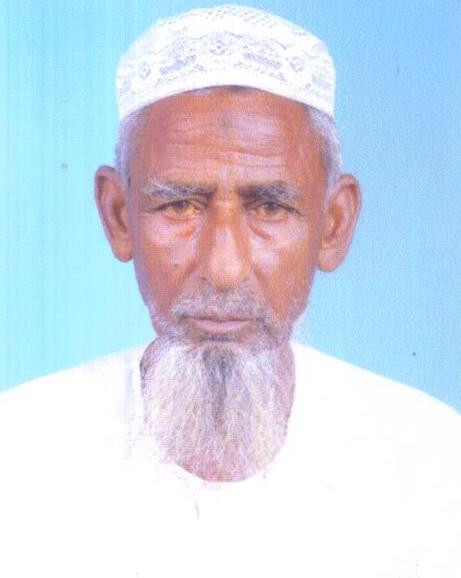 |
Sikandar Ali is a legend in
the Syloti Nagree Puthi-paath arena. He was a regular puthi-pathak of
Sylhet Betar during 1966-1992. He was capable of reading Nagree verses
in verious methods. An inhabitant of Atgaon Dewaner Chak under
Khadimpara U.P of Sylhet and a pupil of Dakshinkach Zahiria School.
He graciously donated the printed copy of
Haltunnabi. Nagree Fonts were finalized incorporating the revisions
suggested by him. He checked the proof of Haltunnabi by conducting
puthi-pather aasor. He knew many persons having Nagree books and
manuscripts in their possession and with his assistance, links and
request several books were collected.
|
Sikandar Ali (1917 - 2009)
|
|
Abdul Quadir
is an active volunteer for searching Nagree puthis and manuscripts in
and around his locality. He is an inhabitant of Fatehpur (Haripur)
having his residence very near Well # 6 of the gas field.
He has amazing speed and stamina in
walking and capable of crossing every terrain on foot. Whole of Sylhet
sadar, Jaintapur, Kanaighat, Guainghat areas are his haunting places.
Due to his approach, local dialects and innocence, he is acceptable to
all villagers specially the ladies, which has helped him in locating
Nagree books and manuscripts for our mission.
|
|
| |
Abdul Quadir
|
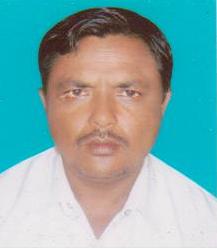 |
An inhabitant of Pirer Chak under Khadimpara U.P
Mr. Baada is providing active support to
the search team. He has a baby taxi which can ply through the village
roads and he charges bare minimum for this drive.
He also remains updated with the
information on Nagri books through his personal network people.
Accordingly, nagree puthi collection drives are organized. He has become
acquainted with the requirements of the mission and contributing his
best.
|
Md. Ilas Ali (Baada)
|
|
|
| |
Mridul Nandy is an active volunteer for searching
Nagree puthis and manuscripts in and around Assam , Shillong
& Jaintia Hills area.He is an inhabitant of Shillong having his residence
in North-Eastern States of India,he has amazing ability to speak fluently in
local languages of North-East like:khasi,Garo,Assamese,Nagamese,kokborok, Nepali.Whole
of Shillong, Jaintia Hills, Silchar,Karimganj,Badarpur,Dharmanagar,Nagaon,
Kailasahar areas are his haunting places.Due to his approach, local dialects
and innocence, he is acceptable to all villagers specially the Sylheti, which
has helped him in locating Nagree books and manuscripts for our mission.
|
|
 |
|
|
|
|
|
Sylhet Nagree
Brief on Research Scholars |
|
|
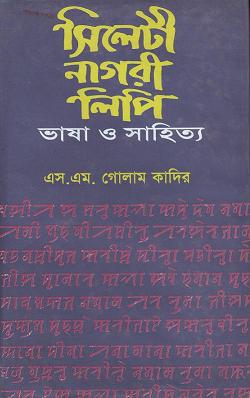 |
Sylheti Nagree is the name of an
alternative script of Bengali lingual literature for writing, reading
and teaching. In greater Sylhet region, this script originated in the
seventeenth century. This script was widely cultured there throughout
eighteenth and nineteenth century. As a result, more than hundred books
were composed, printed and circulated. Even, its pursuing continued
till the earlier part of twentieth century. But this meaningful
heritage almost remained unknown to the majority of Bengali speaking
people.
Matters related to origination, development and
fate of Sylheti Nagree have been followed in this book in light of
historical focus. Analysis and considerations on sources and
characteristics of raw material and ingredients of this unprecedented
script have been done with the help of various references. Short
discussions were made on reading and teaching methods of this script;
and on the form and nature of regional language used in the literatures
composed by this script.
This book accomplishes the
effort of extracting the real identity and dignity of Sylheti Nagree
script, language and literature by discussing the features, theme and
extracts of several citable Nagree books.
|
| Dr. Golam Quadir ( March 17,
1933 - February 05, 2011) was born at Chamardani, Dharmapasha under
Sunamganj district. He read in various institutes of greater Sylhet
upto graduation and obtained his Masters degree from Dhaka University
in 1959. He completed Ph.D in 1983. His career was dominated by
teaching profession which continued after his formal retirement from
Mymensingh A.M. College. Apart from this research work, he has several
other publications. |
|
Dr.
Muhammed Sadiq, in his exceptional research "Sylheti Nagri: Fokiri
Dharar Foshol", has once again attested that in the midst of darkness
all around, someone remains awaked with the hope of light. Essentiality
of light is established by discovery of light. He hasn't forgotten the
smell of water at roots in the glorious-land even at exile far away
from the boundary of Bengal. Being one of the best poets of wavy
eighties, a son of greater Sylhet has not forgotten his obligation
towards intellect practice. And more significantly selects the
root-attached lighted legends and myths as the topic for educational
research. Another word which should obviously be spelled that almost
all researchers depend on instant desires in selecting the
research-topic and even after commencing the task soon get surrounded by
hesitation and doubt. Gradually the prospects and substance that lie
in the subject become apparent to them. Merely few out of these
researchers transit to reality of life from the theme of the subject.
|
|
| Prior to commencing or after
the conclusion of the research, there exists no relevance of the
academic project in determining the sought and substance of life. Dr.
Sadiq is a bright and ideal exception in this respect. Remaining
occupied with the administrative functions as part of service, he could
still keep alive immense interest on Sylheti Nagree Lipi and spiritual
literature of the Fakirs who have renounced the world. By moving, year
after years, to different towns and villages of Sylhet, Sunamganj,
Habiganj and Moulvibazar he has collected samples on Sylheti Nagree
Lipi and manuscripts, printed books and writings on the same. |
Let Dr. Sadiq's book
bring hope of revival to the multiple crisis-depressed readers. Let it
spread the blended shadow of blue-antimony and ancient-memory by
removing arrogant mesh that prevails; and reestablish the significance
of essence in diversely-torn life. Readers, let us join this
rediscovery and renewing second-acquaintance of root-touch light. There
is no sign of completeness or end-point in this book, but has only
announcement of a new beginning.
Sylheti- Nagari Script
|
|
|
|
|
|
|
The blog was posted by Mridul Nandy.
E-mail:sylhetijagaranmancha@gmail.com
|
|
|
|
|
|
|
|
|
|
| | | | | | | | | |
| | |
| | | | | | | | | | | | | | | | | | | | | | | |
| | | |
|
|
|
|
|
|
|






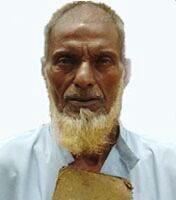



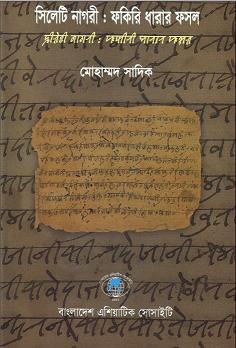

No comments:
Post a Comment